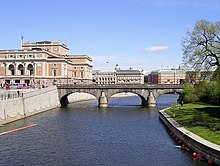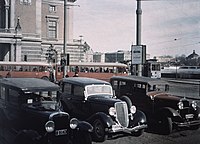History of Stockholm
[1] The most established explanation for the name are logs driven into the strait passing north of today's old town which dendrochronological examinations in the late 1970s dated to around 1000.
While no solid proofs exists, it is often assumed the Three Crown Castle, which preceded the present Stockholm Palace, originated from these wooden structures, and that the medieval city quickly expanded around it in the mid 13th century.
[5][6] Under any circumstance, during the end of the 13th century, Stockholm quickly grew to become not only the largest city in Sweden, but also the de facto Swedish political centre and royal residence.
[7] However, as late as the 16th century, reigns of Kings Eric XIV and John III, whose Swedish government often travelled with them elsewhere (see below), the city was still not what could be called a national capital in modern terms.
[10] By the end of the 15th century, the population in Stockholm can be estimated to 5,000–7,000 people, which made it a relatively small town compared to several other contemporary European cities.
During the reign of Gustav Vasa the city's fortifications were reinforced and in the Stockholm Archipelago, Vaxholm was created to guard the inlet from the Baltic.
Throughout the era, Sweden could hardly claim the level of government and bureaucracy requisite to a capital in the modern sense, but Stockholm was the kingdom's strongest bastion and the king's main residence.
As Eric XIV's pretensions were on par with those of Renaissance princes on the continent, he afforded himself the largest court his finances could possibly support, and the royal castle was thus the biggest employer in the city.
The surrounding ridges, unable to boast a single timber framed building, were mostly used for activities that either required a lot of space, produced odours, or could cause fire.
[14] Following the Thirty Years' War (1618–1648), Sweden was determined never to repeat the embarrassment experienced following the death of Gustavus II Adolphus (1594–1632) when Stockholm, still medieval in character, caused hesitation on whether to invite foreign statesmen for fear the lamentable appearance might undermine the nation's authority.
In a letter in 1636, Chancellor Axel Oxenstierna (1583–1654) wrote that evolving the Swedish capital was a prerequisite for the nation's power and strength and that this would bring all the other cities on their feet.
It was one of the best natural harbours of the era and throughout the 17th century, countless foreign visitors marvelled at the sight of large ships "with 60 or 70 cannons" moored along the eastern quay next to the royal castle.
[22] In contrast with other Swedish cities, all of which were self-supporting, Stockholm was completely dependent of the transit passing through the city—it had, for example, about the same number of domestic animals as Uppsala, which only had ten per cent the population of the capital.
However, during the latter half of the century, the rapidly growing capital could not be supported by the Lake Mälaren region alone and therefore became dependent on corn imported from the provinces.
[23] Sweden had played a passive role in international trade during the 16th century; German merchants and ships managed the export of Swedish primary products such as osmond iron, raw copper, and butter.
This export was largely regarded as a means of securing the import of items not available in Sweden, such as salt, wine, and luxury goods demanded at the court.
With the introduction of a mercantile doctrine around 1620, trade became a keystone to governmental income and the Swedish economy subsequently focused on export, not of raw materials, but of refined products.
Over the entire period (c. 1590–1685), Stockholm's share of the national economy remained stable at around two-thirds, but during the first half of the 17th century, export grew fourfold and import fivefold.
Black death and the sufferings caused by the Great Northern Wars made Stockholm the capital of a shrinking nation, despair which would deepen even further when Sweden lost Finland in 1809.
Notwithstanding Sweden's partial recover of spirit with the union with Norway in 1814, during the period 1750–1850, Stockholm was a stagnating city, with a dwindling population and widespread unemployment, marked by ill-health, poverty, alcoholism, and rampant mortality.
The Mälaren region lost in influence to the benefit of south-western Sweden, and as population and welfare dwindled in the capital, there was a leveling of social classes.
The era saw the rise of the so-called "Skeppsbro Nobility" (Skeppsbroadeln), the wealthy wholesalers at Skeppsbron who made a fortune by delivering bar iron to the international market and by controlling the chartered companies.
[27] During the enlightened absolute monarchy of Gustav III Stockholm managed to maintain its role as the political centre of Sweden and developed culturally.
[30] For Stockholm, the early 19th century meant the only larger-scale projects to be realised were those initiated by the military which favoured a more stiff classicism, the local Swedish version of the Empire style (in Sweden named Karl Johansstil after King Charles XIV John).
Due to the general stagnation, few other constructions were realised — in average ten smaller residential buildings per year — additions which the ambitious city plans of the 17th century could easily handle.
[26] Norrköping became the greatest manufacturing city of Sweden and Gothenburg developed into the key trading port because of its location on the North Sea.
But the booming urban development was also notable in central Stockholm where several prominent Neo-Renaissance buildings were built, including the Academy of Music and Södra Teatern.
[30] In 1866, a commission led by Albert Lindhagen produced a city plan for the ridges (malmarna) designed to offer citizens light, fresh air and access to Swedish nature by mean of parks and plantations.





Painting by Georg von Rosen , 1864


Copperplate by Frans Hogenberg around 1570–80.

Copperplate by Frans Hogenberg .


Engraving from Suecia Antiqua et Hodierna around 1690.



















